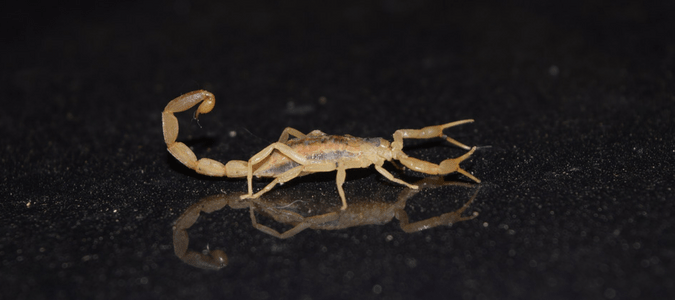
Scorpions may be small, but their stings pack quite a wallop! While the pesky critters can be found in states like Florida and Arizona, there is one species that we are most likely to see here in Texas: the striped bark scorpion.
Let’s learn more about one of the most common types of scorpions in texas and answer some common questions: where do scorpions live? Why do they sting? What should you do if you get stung? How can you avoid falling into their clutches?
What You’ll Learn:
- Types of Scorpions
- Striped Bark Scorpion Appearance
- Striped Bark Scorpion Habitat and Habits
- How Bad Is A Striped Bark Scorpion Sting?
- How to Treat A Striped Bark Scorpion Sting
- How to Avoid The Striped Bark Scorpion
Types of Scorpions
Scientists estimate that there are approximately 1,500 different species of scorpions around the world. You will find some of the most poisonous scorpions in the world in Mexico. The most dangerous scorpion in the United States is the Arizona bark scorpion (Centruroides exilicauda), which lives in the Sonoran Desert.
The bark scorpion is one of 18 native types of scorpions in Texas, mostly located in West Texas. Although all scorpions can sting, none of these types of scorpions are considered lethal.
In the eastern part of the state, there is just one species of scorpion: Centruroides vittatus, otherwise known as the striped bark scorpion. This type of scorpion is the most common throughout the entire United States. Typically a yellow-tan color, with two darker stripes down its back, this scorpion grows to be about two and a half inches in length. Similar to its relatives, striped bark scorpions live under rocks and debris, wood piles and inside buildings. We often find these scorpions in barns, attics and other out-of-the-way structures.
Striped Bark Scorpion Habitat, Appearance And Habits
You may have initially identified this critter as one of the many brown spiders in Texas, which is an easy mistake. Striped bark scorpions are tan-colored arachnids with broad bodies which taper down to a distinctive tail. As you might guess because of its name, the striped bark scorpion is notable because of its two dark stripes on the anterior surface of the abdomen. Similar to spiders, these creatures have eight legs and no wings, but they also come equipped with a pair of vicious-looking pincers in the front and a curled tail that’s loaded with venom. Although scorpions do not see very well, they have two eyes near the top of their head and between two to five eyes on the side of their head.
So, where do scorpions live? As nocturnal creatures, they usually hide out during the day under logs (hence the “bark” part of the name) or piles of trash, both to avoid light and heat and to conserve moisture. These one to three inch objects of fear actually can overheat in the intense sun in Texas and other warm regions. At night, they hunt prey, which includes other arachnids, insects and even fellow scorpions. You can find a striped bark scorpion in many different types of landscapes, including deserts, grasslands, stands of juniper, rocky slopes and even pine forests. This species of scorpion is known for its climbing ability, so homeowners often report finding these creatures in their attics.
Like some snakes, scorpions are venomous. The stinger in their tails contains venom with neurotoxins that can be very painful, and in some cases, even fatal. Scorpions use their stingers both to kill prey and for self-self-defense.
How Bad Is A Striped Bark Scorpion Bite?
The sting of the Centruroides vittatus species definitely packs a punch. When someone gets stung by this species, however, most victims won’t experience more than temporary pain, and medical care is rarely necessary.
What does a striped bark scorpion sting feel like? In fact, it feels very similar to that of a bee or wasp and causes about 30 minutes of sharp or burning pain. There may also be limited swelling and discomfort around the sting for about a day.
In some cases, a striped bark scorpion sting can cause an allergic reaction to the venom that can lead to anaphylactic shock. After being stung, if someone experiences severe abdominal cramping, nausea, seizures, shortness of breath or difficulty breathing, call 911.
What To Do If You Get Stung
For most striped bark scorpion stings, there’s little that needs to be done, other than treating the immediate area for pain and swelling. If you get stung, here are some things you can do to reduce your discomfort:
- Wash the affected area with soap and water
- Remove rings and other jewelry in case of swelling
- Apply cold compresses or ice packs
- Take over-the-counter pain medication
Symptoms can persist for several days.
How To Avoid Scorpions
Scorpions are nocturnal, meaning they are most active at night, preferring to spend their days in dark holes and crevices. They also tend to be more common in rural neighborhoods and suburban areas than in cities.
Because of the potential for having a close encounter with a scorpion (as well as fire ants, spiders and other unpleasant critters), it’s always a good idea to wear gloves when moving rocks or wood piles. Be wary of BBQ pits that haven’t been used in a while, as well as mailboxes, items stored in sheds and tool boxes and any other enclosed spaces where scorpions might be hiding. Also, be sure to keep your yard free of debris so scorpions have fewer places to hide.
To keep scorpions and other stinging pests out of your home, apply weather stripping around doors, store all firewood outside, use window screens and fill in cracks in your home’s exterior. Caulk around pipes, AC drainage and other potential entry points.
ABC Can Help Protect You From Scorpions
Striped bark scorpions can become a real nuisance, especially in the summer. If you’re running into problems with scorpions, spiders or insects getting into your home or business, give ABC Home & Commercial Services a call. We will send out an experts to inspect your property for access points and come up with a plan to prevent scorpions from getting inside your home.
